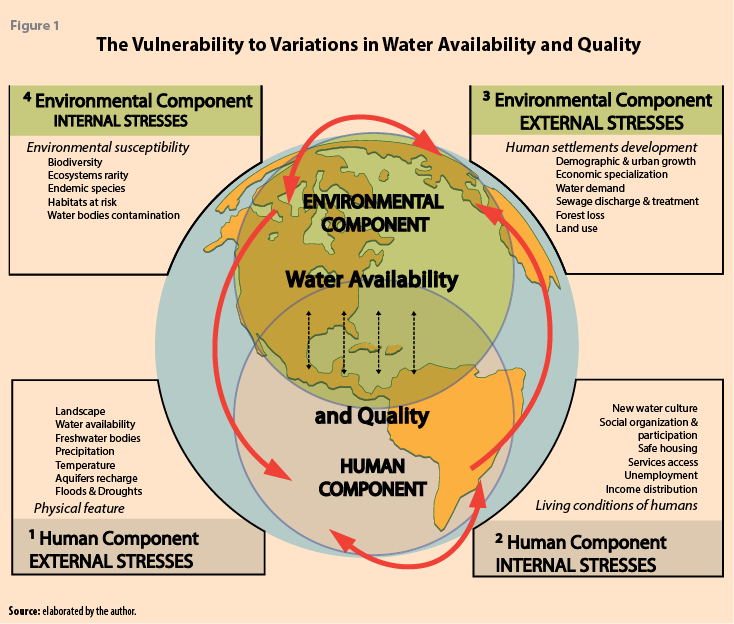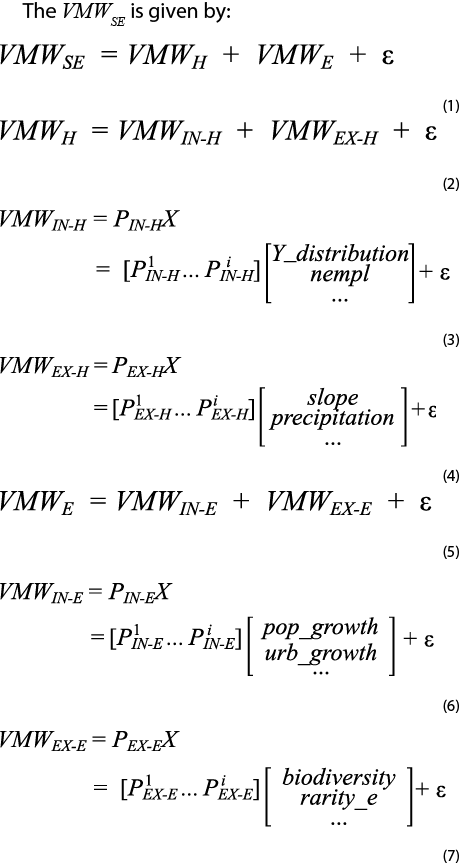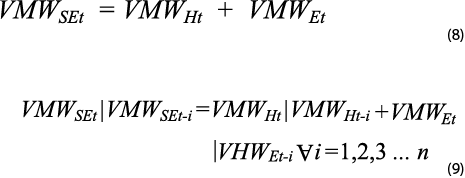An alternative framework for analyzing the vulnerability of socio-ecological systems

|
Because uncertainty is a part of life, both humans and environment face systematic and permanent changes. In order to predict and prevent negative and long-term impacts from human actions and environmental changes, we require alternative theoretical and methodological frameworks. Vulnerability is a useful theoretical tool for this purpose. This article attempts to expand our current understanding of socio-ecological system vulnerability by using a comprehensive and dynamic approach that considers the systems’ complex nature. Certain mathematical and computational tools can be used for modeling vulnerability as a complex concept. This manuscript exemplifies the use of complex system theory to assess the vulnerability that resulted from changes in both water quantity and quality. Key words: vulnerability; socio-ecological system; system interactions; complex systems; system modeling; environment. |
Debido a que la incertidumbre es un hecho de la vida, los seres humanos y el medio ambiente enfrentan cambios sistemáticos y permanentes. La predicción y prevención de impactos negativos de largo plazo resultado de acciones humanas y cambios ambientales requieren marcos teóricos y metodológicos alternativos. La vulnerabilidad es una herramienta teórica útil para este propósito. Este artículo trata de ampliar nuestra comprensión actual de la vulnerabilidad de los sistemas socio-ecológicos mediante el uso de un enfoque integral y dinámico que considera la naturaleza compleja de los sistemas. Ciertas herramientas matemáticas y computacionales se pueden utilizar para el modelado de vulnerabilidad como un concepto complejo. En el documento se utilizará como ejemplo una propuesta de evaluación de la vulnerabilidad asociada a cambios en la cantidad y calidad del agua. Palabras clave: vulnerabilidad; sistemas socio-ecológicos; interacciones del sistema; sistemas complejos; medio ambiente. |
Recibido: 18 de febrero de 2014.
Aceptado: 15 de octubre de 2015.
1. Introduction
Our current era is characterized by systematic and permanent change. Uncertainty is perhaps greater than ever before in human history. With advances in science and technology, the speed of change has clearly increased. This situation has made it more difficult both to predict the impacts that human actions have on society and the environment, as well as to identify in advance their long-term consequences.
Many human decisions and actions –such as city growth, natural resource exploitation, deforestation and reforestation, environmental pollution, energy production and consumption, among others– have had several negative impacts on the environment over the last century. These impacts have generated more complex interactions between humans and the environment, as well as feedback loops. Evidence of these more complex interactions between the human and the environmental system includes temperature variability, glacier melting, safe water availability reduction, biodiversity losses, species endangerment, landscape modification, desertification, and increases in the magnitude and frequency of natural extreme events, such as floods, sinks, and earthquakes.
Vulnerability is a useful concept for understanding these impacts on socio-ecological systems –composed of humans and the environment (flora, fauna, freshwater, weather, soil and biodiversity)–, and their interactions among system components. This concept refers to the susceptibility –the predisposition of systems to be affected or damaged– of the socio-ecological systems to perturbations or stresses, and also to the lack of capacity of these systems to face or cope with those variations (Adger, 2006; Wisner et al., 2004; Turner et al., 2003; Alwang et al., 2001; IPCC, 2014; Smit and Pilifosova, 2001; Bohle et al., 1994).
Several studies have analyzed the concept of vulnerability as an intrinsic human characteristic from theoretical and empirical perspectives. Some of these studies have focused on the impacts that the environment has had on humans, without considering the consequences that people’s decisions and actions could have on it. Others have explored how human behavior has increased people’s vulnerability; however, these studies have not included the interactions that exist between humans and the environment.
Recently, with the increasing study of climate change, diverse advances have been made in analyzing system interactions and in exploring human-environmental system linkages by addressing the effects caused by human decisions and actions on climate variations. Nevertheless, it is still necessary to make these advances operative within a more general framework, and also to apply this perspective to the study of other interactions in socio-ecological systems, besides climate variability.
To estimate socio-ecological system vulnerability more sophisticated methods are required. This task has become a major challenge due to the insufficiency of reliable and temporal information (what is meant by), in addition to the methodological difficulties of modeling systems feedback. For several reasons, Systems Theory is considered the best theoretical framework for analyzing permanent changes (with or without time interruptions) in socio-ecological system susceptibility. This theory is based on processes rather than single events because it is focused on the connections and interactions among systems and system-components. The outcomes of those connections and interactions can cause either the evolution or the extinction of systems as they acquire new properties. The outcomes are distributed differentially among systems and their components (Bellomo, 2008; Ivancevic and Ivancevic, 2008).
This article discusses the complexity of socioecological system vulnerability. It addresses the most important approaches that have been used to study the concept of vulnerability and explains why it should be analyzed as a complex system, since they exhibit characteristics such as dynamism, non-linearity, emergent properties, and self-organization. This manuscript also explores various methods that can be used for modelling vulnerability as a complex system such as Multi- Agent Models,
Bayesian Statistics, Fractal Analysis, Fractional Calculus, and Game Theory. Finally, it exemplifies the use of complex system theory to assess the vulnerability that resulted from changes in water quantity and quality.
2. Approaches to the Study of Vulnerability
In the last two decades, several advances have been made in modeling the concept of vulnerability. These models have become useful tools for reducing socio-ecological system susceptibility to different stresses or perturbations. Model results are important inputs in the implementation of policies and plans for risk reduction. For example, Chambers (1989) finds that vulnerability arises from external and internal factors. While external factors are related to a system’s exposure to shocks (unpredictable events) and stressors (predictable and continuous events), internal factors refer to a system’s capacity to cope with hazards.
Improving upon Chamber’s ideas, Watts and Bohle (1994) define vulnerability as a multidimensional and multi-scale concept. Although they identify several relationships that exist between vulnerability and people’s coping capacities, they simplify this concept to a human characteristic. Coping capacities include strategies and actions that allow people to respond after a disaster occurs, but do not include prevention measures. Therefore, coping capacities are related to the manner in which people and organizations use available resources and abilities to fac e negative impacts of disasters.
The International Strategy for Disaster Reduction [UNISDR] (2012) emphasizes that vulnerability is a multidimensional concept, where physical, social, economic, and environmental factors can increase or reduce people’s susceptibility. The UNISDR also assumes that the environment constitutes an external factor that can threaten human life.
Using the Pressure and Release Model (PAR), Wisner et al. (2004) address the concept of vulnerability in different spatial and temporal scales, analyzing the root causes, dynamic pressures, and unsafe living conditions. Although they examine the degree to which people, livelihoods, and properties are at risk, they do not include the interactions between human and environmental components of socio-ecological systems.
The Intergovernmental Panel on Climate Change [IPCC] (2014), Smith et al. (2001), and Ford and Smit (2004), all explain vulnerability as the sensitivity of social, physical or ecological systems related to climate change. For these authors, vulnerability has a geographical, temporal, and social scale since climate change is a multi-scale problem that is influenced by several actors and stressors. However, the definitions they propose only address feedbacks on climate change that affects socio-ecological systems and do not incorporate those interrelations that go beyond climate variability. For the IPCC, climate change is related to variations on the climate caused directly or indirectly by human activity, which affect the composition of the atmosphere and that are additional to the natural climate variability that the Earth experiences regularly (IPCC, 2014).
More integrated approaches to the concept of vulnerability are proposed by Berkes and Jolly (2001), Brook (2003) and Adger (2006). These researchers point out that vulnerability is involved in both physical and social systems’ susceptibility to multiple stresses generated by environmental and social changes. Because socio-ecological systems adapt to climate change on multiple scales, adaptation actions to increase these systems’ resilience are place-hazard specific. These authors define adaptation as the ability, characteristic, and behavior of systems to adjust to climate change and cope with its effects (Brook, 2003; Burton et al., 2002).
For Janssen et al. (2007), social and ecological systems are organized around continuous change from their highly uncertain environments. In so doing, systems trade off their capacity to tolerate certain types of variability but become highly susceptible to others because they cannot be robust to all types of variability and disturbances. This process of trading off among different types of variability and disturbances is known as Highly Optimized Tolerance (HOT). According to these authors, attempts to increase systems adaptation can reduce their ability to cope with changes resulting from lost ability to reorganize and recover after disturbances.
Consequently, depending on the definition of vulnerability, different interrelations among socio-ecological systems and system components are analyzed. However, vulnerability cannot be reduced to an intrinsically human characteristic generated by external or independent stresses, since it is a complex concept which exhibits characteristics such as dynamism, non-linearity, emergent properties, and self-organization. The presence of these characteristics has important theoretical and methodological implications, and making them operative is not a simple task. Although several studies have improved our understanding of system vulnerability, a more general framework that addresses this phenomenon and considers its complex nature is also needed.
3. An Alternative Approach to Vulnerability as a Complex System
Most of the systems and system-component interactions around the world have complex behaviors (Bossomaier, 2000; Helbing, 2008). When a system exhibits these properties, it is more convenient to analyze it as a complex one. Examples of complex systems include economies, social groups, ecosystems, social insects, climate, telecommunication infrastructures, cells, immune and nervous systems and traffic light control.
This research defines vulnerability as the systematically adjusted susceptibility of socio-ecological systems that influences, either favorably or adversely, the capacity of system components –human and environmental– to face, adjust to, or cope with permanently changing stresses. These stresses can be generated internally or externally. First, vulnerability is a dynamic concept. It is associated with environmental and social changes that can occur gradually (e.g., groundwater reduction) or as a single event. For example, societies and environments worldwide are threatened by insufficient water supply, low quality of water, and catastrophic floods. These threats are explained by environmental and social changes, which include climate variations, population and economic growth, water source pollution, and infrastructure insufficiency (Wolff and Gleick, 2003; WWAP, 2003).
Second, vulnerability is a non-linear and multi-scale concept. It is not evenly distributed among social groups, spatial units, or time. Moreover, socio-ecological systems’ susceptibility to variations in water availability and quality depends on past and current situations, which can increase or decrease the systems’ capacity to face different stressors. For instance, water availability is unevenly distributed among regions, seasons, years, social groups and economic activities. It is known that rainfall increases in high latitudes and some equatorial regions, and that it decreases in mid-latitude, subtropical and semi-arid regions. Consequently, some regions in the world face water scarcity, while others have an abundance of water (Schneider et al., 2001).
Third, vulnerability is a concept with emergent properties. Stressors can have predictable and unpredictable impacts on socio-ecological systems. Because stressors can be external or internal to systems, both positive and negative feedback can originate from either human or environmental components. Examples of emergent properties include floods and droughts caused by seasonal variations in temperature and rainfall; water-availability modifications as a result of dam construction and water transference from increasingly distant sources; and inadequate water distribution due to poorly maintained or insufficient hydraulic infrastructure.
Four, vulnerability is a concept with the property of self-organization. Impacts of internal and external stressors on socio–ecological systems can modify system interrelations and system components. Changes to system structures can prompt system adaptation, evolution or extinction. Socio–ecological systems’ survival depends on their adaptive capacities to cope with negative impacts from stressors. These adaptive capacities make systems more prepared to move into a less vulnerable condition.
Adaptive strategies to cope with negative impacts from climate change include weather warning systems, vaccinations programs, sea-level rise and temperature variation assessments, crops substitution, water conservation projects, and flood-control engineering practices (OECD, 1999; Schneider et al., 2001; Tompkins and Adger, 2003). However, climate change impacts are not evenly distributed among social groups, spatial units, or time. Therefore, socio-ecological systems’ vulnerability depends on past stressors, which can increase or decrease the capacity of the systems to face different perturbations and stressors. For example, as a result of the vulnerability to variations in water, its availability and quality, water systems’ capacity to supply safe and sufficient water will be uncertain. For instance, water availability is unevenly distributed among regions, seasons, years, social groups and economic activities.
Although to analyze socio-ecological systems’ vulnerability using a complex systems’ approach is more accurate for implementing effective policies, strategies, and actions to reduce systems’ susceptibility to variations in water availability and quality, there are several theoretical and empirical difficulties to accomplish this task. For instance, there is a fuzzy division between the human and environmental components, in addition to complicated models which sometimes are unable to be solved, and that are used to assess system-component interrelations.
Given the dynamic, non-linear, multi-scale, unpredictable and self-organizing nature of the concept of vulnerability, an interesting question arises: can vulnerability be modeled as it is proposed theoretically in this article?
4. Modeling Vulnerability: Future Trends
There is no unique method for estimating vulnerability. Indeed, this concept has been studied in different spatial levels and with several methodological tools. Models are a simplification of the real world, and without this simplification it would be harder –if not improbable– to understand and explain it. Because socio-ecological systems exhibit complex properties, the study of their vulnerability should recognize this fact. One of the most accepted ways in which vulnerability has been calculated is through indices. Frequently, vulnerability indices are linear combinations of standardized variables. The weights of these indices parameters are determined exogenously. Nevertheless, they can also be estimated endogenously. Regularly, vulnerability indices are computed at one point in time, without capturing the complex nature of socio-ecological systems’ susceptibility to different stresses and perturbations.
Most vulnerability models are concentrated on the systems’ steady state. They assume there are equilibrium positions in the outcomes of system interactions, and that systems are not affected by any stress or perturbation. Contrary to this ideal situation, almost all real systems in the world have non-linear behavior because linearity is just a simplification. When the analysis is based on the overall effects on systems and not on small deviations, linearity is a useful approximation that smooths system s’ uncertainties.
Several advances in mathematical and computational tools such as Multi-Agent Models, Bayesian Statistics, Fractal Analysis, Fractional Calculus, and Game Theory can be useful for modeling the concept of vulnerability in a more sophisticated manner. For instance, in Multi-Agent Models individual agents and their interactions are simulated, using qualitative and quantitative rules that are followed by agents. These rules can be modified whenever system interactions change. Some examples of multi-agent models include genetic algorithms, artificial life simulations, cellular automata, and neural networks (Weiss, 1999). Similarly, Bayesian networks analyze system interactions based on a conditional probability distribution, which incorporates different degrees of uncertainty. Bayesian networks can update system interactions and estimate their likelihood (Koch, 2007).
For Fractal Analysis, system interactions are considered recursive feedback. Thus, outcomes from previous stages are fed into and influence the next ones. Feedback impacts are estimated by iterated equations based on the idea of fractals –complex interactions that have a relatively simple behavior. A fractal is a fragmented geometrical shape, which can be divided into several parts. Fractals are considered a copy of the whole because they exhibit the properties of self-similarity and fractional dimensionality (Lapidus and van Frankenhuijsen, 2006).
Fractional calculus has been used for analyzing complex systems through derivatives and integrals of non-integer order. Models using fractional calculus can explain the chaotic behavior of systems and their transition from chaotic stages to linearity. Because these models can capture a system’s sensitivity to changes in its initial conditions and properties, they can also predict the system’s trajectory (Grigorenko and Grigorenko, 2003; Wang and Changpin, 2006).
Finally, Game Theory has diverse models to study dynamic systems and interactive decision-making processes. For example, evolutionary game models analyze both change in random decisions and also adaptation strategies. As a result of learning processes, systems are modified and adapted to either cooperate or compete (Hofbauer J. and K. Sigmund, 2003).
The previously mentioned advances in mathematical and computational tools allow the complex behavior of socio-ecological system vulnerability to be both analyzed and predicted. Using these more sophisticated tools, different degrees of uncertainty can be incorporated in systems and system-interaction modeling. As a result, modelers will have a better approximation of the real world.
5. Vulnerability Model to variations in Water Availability and Quality
Socio-ecological systems are constituted by humans, the environment, and the permanent interactions among them. Human decisions and actions, as well as environmental processes, can modify socio-ecological systems vulnerability to different stresses and perturbations by influencing the systems’ capacity to face, adjust, or cope with variations such as changes in water availability and quality.
Positive and negative feedback to socio-ecological systems’ vulnerability can be generated by internal or external stressors from the system components: human and environmental. The external stresses for the human component –which comprises people, settlements, infrastructure, economic activities, land uses, and government, among others– are constituted by physical features. These include slopes (slope) and sinks (sink) of landscape, natural water availability (w_availability), freshwater bodies existence (w_bodies) (e.g., rivers, lakes, aquifers and springs), precipitation (precipitation), temperature (temp), aquifers’ recharge conditions (aquifers), and areas that can be affected by floods and droughts (climate_a) (1) (Figure 1).

The internal stresses for the human component are associated with social, economic, political and cultural conditions in which people live. Some of these internal stresses are income distribution (Y_distribution), unemployment (nempl), wages (wages), access to basic services [e.g., education (edu), health (health), water supply (w_supply), sanitation (sanitation) and electricity (electricity)], safe housing (s_house), social organization and participation in water management decision (governance), governmental attention of social demands (g_attention), and a new water culture based on a more rational consumption (nw_culture) (2) (Figure 1).
Similarly, the external stresses that impact environmental component susceptibility –such as flora, fauna, freshwater bodies, weather, soil and biodiversity– are determined by human settlements’ growth and urban-economic city development. Examples of these external stresses to the environmental component are demographic (pop_growth) and urban growth (urb_growth), economic specialization (ec_specialization), water demand increases (w_demand), sewage discharge and treatment (or its absence) (sewage_d&t) , forest loss (f_loss), aquifers’ recharge areas urbanization (urb_aquifers), garbage generation and final disposal, water leakages existence (w_leakages), and land-use distribution (land_use) (3) (Figure 1).
The internal stresses of the environmental component are associated with the biodiversity (biodiversity) and rarity of ecosystems (rarity_e), the presence of endemic species (endemic_s), the fragility of species to modifications on their habitats (fragility_s), the number and extension of habitats at risk due to variations in water quantity or quality (hab_risk), the propensity of aquifers to be polluted (prop_aquifers), and the levels of contamination in water bodies (contam_wbodies) (4) (Figure 1).
Because complex interactions are known to occur between human settlements and the environment two interrelated models can be estimated: Principal Component Models (PCM) and Multinomial Logit models.
5.1 Principal Component Models
With PCM, it can be determined if socio-ecological systems are becoming more vulnerable to variations in water availability and quality in the two study areas. These models transform correlated variables into a small number of new uncorrelated variables known as principal components (or eigenvectors) using orthogonal linear transformations. Principal Component Analysis (PCA) minimizes least mean square error by compressing a set of high dimensional vectors (M) into a set of lower dimensional vectors (L) by reconstructing the original data set based on covariance analysis between data, the variance of data, and the estimated components. The greatest variance of data set is explained by the first principal component. The second greatest variance of data set is concentrated on the second principal component, and so on (Shlens, 2009; Jolliffe, 2002; Stevens, 2002).
PCM, which constitute a method for data reduction, have several advantages and disadvantages. For example, some of their advantages are that it is possible to extract relevant information from confusing data sets, finding hidden relations among variables. These models synthesize different variables that were measured with diverse units into few indices, avoiding modeling problems related to multicolinearity and heteroscedasticity.
This data reduction method also has some limitations. For instance, these models are estimated as linear combinations of original data sets. Although linearity can simplify the analysis of complex data structure, some samples do not exhibit a linear behavior. Besides, the compression of variables into few indices can incur in loss of relevant information (Shlens, 2009; Sharma, 1998).
Socio-ecological systems vulnerability to variations in water availability and quality, is estimated by the Total Vulnerability Model to Water Variations (VMWSE). This model is composed of two elements whose variables were selected depending on their capacity to explain systems’ susceptibility to the aforementioned water variations. The first element estimates the human vulnerability to variations in water availability and quality (VMWH). This element is associated with the living conditions of the two study areas’ inhabitants (VMWIN-H) and their physical context characteristics (VMWEX-H). The second element measures the environmental component vulnerability (VMWE), which can be explained by ecosystems’ fragility and biodiversity (VMWIN-E), as well as by the environmental impact of human growth and economic activities (VMWEX-E).

where
X is the original data set
VMWSE is a new representation of the original data set X
P is the matrix of eigenvectors that transforms X into VMWSE
5.2 Multinomial Logit Models (MNL): Policy Decision-Making Tool
To solve PCM limitations, in the second step of this methodology, MNL are estimated according to PCM results. MNL can capture the sensitivity generated by changes among variables. Therefore, these models can address the dynamic nature of socio-ecological systems’ vulnerability to variations in water quantity and quality. Future vulnerability scenarios of the socio-ecological systems can be predicted.
Changes on socio-ecological systems vulnerability to variations in water quantity and quality must be considered over time since recent systems vulnerability (VMWSEti) depends on previous systems susceptibility (VMWSEt-i):

With Multinomial Logit Models (MNL) the dynamic behavior of socio-ecological systems’ vulnerability can be analyzed. These models are a useful water-policy tool for decision-making, because they can measure the interrelations among variables with simple equations. As a result, these models represent a convenient way to predict future events based on expected changes over variables.
Although these models are frequently affected by multicolinearity and heteroscedasticity (Greene, 1990; Kleinbaum, 1994; Sharma, 1998), these problems for modeling did not affect the calculated MNL, because the estimated data inputs were generated by PCM, which avoids them.
Systems’ vulnerability to variations in water quantity and quality can be reduced effectively by analyzing the elasticity of the components estimated using PCM. Through elasticity results, one can identify the most sensitive factors to variations in water quantity and quality at different spatial scale. The proof of the systems vulnerability’ analysis is scale-dependent (Gibson et al., 2000; Kok and Veldkamp, 2001). Systems’ sensitivity to different spatial scales is also tested.
Elasticity measures the change in socio-ecological systems’ vulnerability (the dependent variable) caused by a unit change in either human or environmental components (the independent variables). Consequently, elasticity can be used to predict long-term impacts on socio-ecological systems’ vulnerability generated by water policy-decisions. If elasticity has a lower value, socio-ecological systems’ response to changes is lower. In contrast, if elasticity has a higher value, systems respond faster to variations.
It is expected that at more detailed scales, both human and environmental components of socio- ecological systems exhibit a dynamic and non-linear nature by including more complex interactions and feedback. These can be hidden when data is added in higher spatial units. Besides, the impacts at different spatial scales may differ in the same interaction or feedback. For this reason, this research represents an effort to identify the best spatial scale for analyzing systems vulnerability, which have not received enough attention.
6. Conclusions
Methodological gaps remain to transform the concept of dynamic vulnerability into accurate measures for supporting the decision making processes. This is partly due to the complexity of human and environmental interactions. However, the advantage of understanding the dynamic nature of vulnerability goes beyond identifying groups or areas that require an immediate intervention. It is possible to determine which groups or areas will potentially require some kind of intervention before they become vulnerable.
Dynamic perspective of vulnerability tries to be one step ahead of risk situations and enhance the adaptive capacities of humans and the environment through policies and planning. The challenge consists on increasing our capacities to distinguish between danger situations and sustainable pathways in an uncertain context. Particularly if in most cases we do not know all the consequences of human actions and decisions over the Earth´s systems both externally and internally. Vulnerability does not just generate risks; it also creates opportunities for rethinking and being reflexive with current policies, plans and actions.
When a system has limited adaptation capacities, it is more vulnerable since it can experience irreversible damages. In general, environmental systems are less capable to adapt to changing conditions than human systems. Environmental systems’ feedbacks are autonomous and reactive; in contrast, human systems’ feedbacks can be tactical or strategic. The tactical adaptation of human systems is related to short-term actions for dealing with a problem, and the strategic adaptation is related to long-term actions focus on improving the actual system conditions. Through policy and planning, the human system can enhance its adaptive capabilities, but this requires analyzing the interactions among them and their components.
In consequence, the study of vulnerability needs to play a more relevant role in the decision-making process with the aim of defining and implementing strategies and policies that guarantee a safer world. These strategies and policies must consider the dynamic nature of the world in order to be more effective. Because vulnerability is a multi-scale and dynamic process, previous actions for reducing it will determine the future of human and environmental systems.
7. Acknowledgements
This study was financed by the Mexican National Council of Science and Technology (Conacyt), Project number 221460, CB-2013-01, and by the Ministry of Public Education (SEP)-PROMEP, Project number PROMEP/103.5/13/6642, UAM-PTC-404.
![]()
References
Adger, W. N. (2006). Vulnerability. Global Environmental Change 16 (3): 268-281.
Alwang, J.; P. B. Siegel; S. L. Jorgensen (2001). Vulnerability: A View from Different Disciplines. Discussion Paper Series No. 0115. Washington DC: World Bank.
Bellomo, Nicola (Ed.) (2008). Modeling Complex Living Systems: A Kinetic Theory and Stochastic Game Approach. Boston-Basel-Berlin: Birkhäuser.
Berkes, F. and D. Jolly (2001). Adapting to climate change: social-ecological resilience in a Canadian Western Arctic community. Conservation Ecology 5 (2): 18-33.
Bohle, H. G.; T. E. Downing; M. Watts (1994). Climate change and social vulnerability: toward a sociology and geography of food insecurity. Global Environmental Change 4 (11): 37-48.
Burton, I.; S. Huq; B. Lim; O. Pilifosova; E.L. Schipper (2002). “From impacts assessment to adaptation priorities: the shaping of adaptation policies”. Journal of Climate Policy. 2 (2002). Pp. 145-159.
Bossomaier, T. R. J. and D. G. Green (Ed.) (2000). Complex Systems. New York: Cambridge University Press.
Brooks, N. (2003). Vulnerability, risk and adaptation: A conceptual framework. Norwich: Tyndall Centre for Climate Change Research.
Chambers, R. (1989). Vulnerability: coping and policy. In IDS Bulletin 20 (2): 1-7. Brighton, Sussex: Institute of Development Studies, University of Sussex.
Ford, J. and B. Smit (2004). A Framework for Assessing the Vulnerability of Communities in the Canadian Arctic to Risks Associated with Climate Change. In Arctic 57 (4): 359-400.
Gibson, C. C.; E. Ostrom; T.K. Ahn (2000). The concept of scale and the human dimensions of global change: a survey, Ecological Economics 32 (2000): 217-239.
Grigorenko, I. and E. Grigorenko (2003). Chaotic Dynamics of the Fractional Lorenz System. In Physical Review Letters 91 (3): 034101_1- 034101_4.
Greene, William H. (1990). Econometric Analysis. New York: MacMillan Publishing.
Helbing, D. (Ed.) (2008). Managing Complexity: Insights, Concepts and Applications. Understanding Complex Systems. Berlin-Heidelberg: Springer-Verlag.
Hofbauer J. and K. Sigmund (2003). Evolutionary game dynamics. In: Bulletin of the American Mathematical Society 40 (4): 479-519.
IPCC (2014). Climate Change 2014: Synthesis Report Summary for Policymakers. Intergovernmental Panel on Climate Change. Cambridge: Cambridge University Press.
Ivancevic, V. G. and T. T. Ivancevic (2008). Complex Nonlinearity: Chaos, Phase Transitions, Topology Change and Path Integrals. Berlin-Heidelberg: Springer-Verlag.
Janssen, M. A.; J. M. Anderies; E. Ostrom (2007). Robustness of Social-Ecological Systems to Spatial and Temporal Variability, Society & Natural Resources 20 (4): 307-322.
Jolliffe, I. T. (2002). Principal Component Analysis. Springer. Series in Statistics. Second Edition. Aberdeen, UK: Springer.
Kleinbaum, D. G. (1994). Logistic Regression: A Self-Learning Text, Statistics in the Health Sciences. London: Springer. Koch, K. R. (2007). Introduction to Bayesian Statistics. Berlin-Heidelberg-New York: Springer-Verlag.
Kok, K. and A. Veldkamp (2001). Evaluating impact of spatial scales on land use pattern analysis in Central America, Agriculture, Ecosystems and Environment 85 (2001): 205-221.
Lapidus, M. L. and M. van Frankenhuijsen (2006). Fractal Geometry, Complex Dimensions and Zeta Functions: Geometry and Spectra of Fractal Strings. New York: Springer.
Organization for Economic Cooperation and Development (OECD) (1999). National Climate Policies and the Kyoto Protocol. Paris: OCDE.
Schneider, S.; J. Sarukhan; J. Adejuwo; C. Azar; W. Baethgen; C. Hope; R. Moss; N. Leary; R. Richels; J. P. van Ypersele (2001).
Overview of Impacts, Adaptation, and Vulnerability to Climate Change. In: McCarthy, J.J. et al. (Eds.). Climate Change 2001: Impacts, Adaptation and Vulnerability. IPCC Working Group II. Cambridge: Cambridge University Press. Pp. 77-100.
Sharma, S. (1998). Applied Multivariate Techniques. New York: John Wiley and Sons.
Shlens, J. (2009). A tutorial on Principal Component Analysis. Center for Neural Science. New York: University of New York.
Smit, B.; O. Pilifosova (2001). Adaptation to climate change in the context of sustainable development and equity.
In: McCarthy, J. J.; O. Canziani; N. A. Leary; D. J. Dokken; K. S. White (Eds.), Climate Change 2001: Impacts,
Adaptation and Vulnerability. IPCC Working Group II. Cambridge: Cambridge University Press. Pp. 877-912.
Smith, J. B.; H. J. Schellnhuber; M. Q. Mirza; S. Fankhauser; R. Leemans; L. Erda; L. Ogallo; B. Pittock; R. Richels;
C. Rosenzweig; U. Safriel; R. S. J. Tol; J. Weyant; G. Yohe (2001). Vulnerability to climate change and reasons for concern: a synthesis. In: McCarthy, J.J. et al. (Eds.). Climate Change 2001: Impacts, Adaptation and
Vulnerability. IPCC Working Group II. Cambridge: Cambridge University Press. Pp. 914-967.
Stevens, J. P. (2002). Applied multivariate statistics for the social sciences. Hillsdale, NS: Erlbaum.
Tompkins, E. L. and W. N. Adger (2003). Building resilience to climate change through adaptive management of natural resources. Norwich: Tyndall Centre for Climate Change Research.
Turner, B. L.; R. E. Kasperson; P. A. Matsone; J. J. Mc Carthy; R. W. Corell; L. Christensen; N. Eckley; J. X.
Kasperson; A. Luers; M. Martell; C. Polsky; A. Pulsipher; A. Schiller (2003). A framework for vulnerability analysis in sustainability science. In: Proceedings of the National Academy of Sciences of the United States of America 100 (14): 8074-8079.
United Nations Office for Disaster Risk Reduction (UNISDR) and World Meteorological Organization. (2012).
Disaster Risk and Resilience Thematic Think Piece. Geneva: UNISDR-WMO.
Wang, Y. and C. Li (2006). Does the fractional Brusselator with efficient dimension less than 1 have a limit cycle? In: Physics Letters A 363 (5-6): 414-419.
Watts, M. J. and H. G. Bohle (1993). The Space of Vulnerability: the Causal Structure of Hunger and Famine. In Progress in Human Geography 17 (1): 43-67.
Weiss, G. (1999). Preface. In Weiss, Gerhard (Editor). Multi-agent Systems: A Modern Approach to Distributed Artificial Intelligence. Cambridge, Massachusetts: MIT Press.
Wisner, B.; P. Blaikie; T. Cannon; I. Davis (2004). At risk: natural hazards, people’s vulnerability and disaster. Chapter 2. The Disaster Pressure and Release Model. London-New York: Routledge. Pp. 49-123.
Wolff, G. and P. H. Gleick (2003). The soft path for water. The World’s Water: The Biennial Report on Freshwater Resources 2002-2003. Washington: Island Press. Pp: 1-32.
World Water Assessment Programme (WWAP) (2003). Water for People, Water for Life: The United Nations World Water Development Report. New York: UNESCO Publishing.




